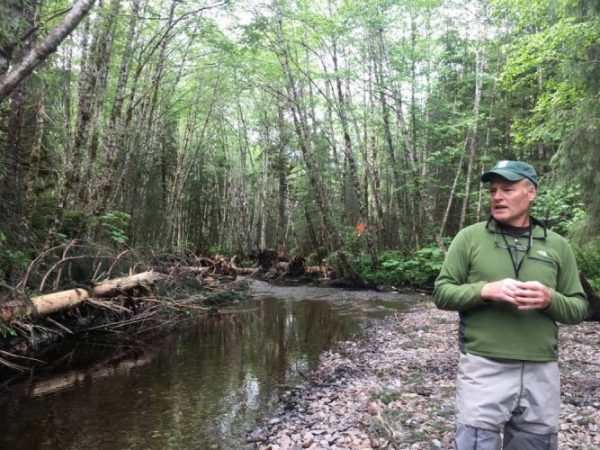
A conservation group is restoring fish habitat: one humble creek at a time. The Southeast Alaska Watershed Coalition recently trudged through one of Wrangell’s streams to improve fish passage. It’s one of many projects throughout Southeast to give salmon a helping hand.
An ordinary salmon’s life cycle is nothing less than a Herculean feat. They spend years fending for themselves and feeding in the open ocean. But it often all starts — and ends — in the tiniest of creeks.
It’s here on Pat Creek where hired help of the watershed coalition are felling second-growth spruce trees. They’re stick into the stream banks.
“We really want it to look natural,” said SAWC Executive Director Rob Cadmus. He calls the work a sort of reverse logging. “We’re not trying to create something that’s new, we’re trying to put it back the way it would be if it wasn’t logged in the first place.”
But it has been logged. Heavily in the 1960s and ‘70s. Cutting this close to the stream isn’t legal anymore. But the damage is done.
So, the group recently spent two weeks in June trying to undo it.
With funds from the U.S. Fish and Wildlife Service and Alaska Sustainable Salmon, the group cut down 31 trees. The woody debris from the logs creates shade from the sun, shelter from predators and slows down the water for juvenile salmon.
Watershed coalition biologist John Hudson explains the problem here.
“What happens to a channel is it becomes very uniform and kind of boring, it lacks all its complexity. For lack of a better term, it looks like a bowling alley, very flat and wide,” Hudson said.
He says that lack of obstacles creates a lot of white water.
“Wonderful if you’re a pink or chum salmon, because you’re just coming up here to spawn and then your offspring are just heading right to the ocean,” Hudson said. “But if you’re a king salmon or sockeye, and there are sockeye here, or Coho, the little fish need places to live, and they don’t like bowling alleys.”
Pat Creek is just one of streams that the coalition is working to restore habitat on. Others include Skagway’s Pullen Creek and Switzer Creek near Juneau.
The state’s done its part by removing culverts and breaching abandoned logging roads to help with fish passage.
So, after all this work and more than $150,000 spent, how many more Coho, pink, chum and sockeye might be saved by this stream work? Hudson doesn’t want to guess. He says there are too many other factors impacting fish survival.
“The ocean where they spend most of their lives is another ballgame where their numbers fluctuate there. And what we did here has no effect on the ocean’s ability to help salmon survive and grow,” Hudson said.
This project won’t count returning salmon. But Hudson says the science shows efforts like these increase the survival of juveniles. The coalition will keep an eye on this stream over the next two years.
“So we’re going to go with the physical monitoring, and just assume if you build it they will come,” Hudson said.
The coalition is planning more stream projects, such as improving habitats and water quality monitoring in Juneau’s Mendenhall Valley’s wetlands and Jordan Creek.




